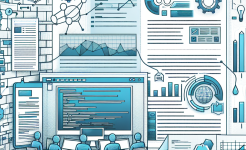Healthcare Industry
The healthcare industry is one of the most critical sectors where the agile development model has made significant inroads. In healthcare, the need for rapid innovation and adaptability is paramount, given the constant evolution of medical technologies and treatment protocols. Agile methodologies have been employed in the development of electronic health records (EHR) systems, where iterative development allows for continuous improvement based on user feedback. For instance, a hospital might start with a basic EHR system and gradually add features such as telemedicine capabilities, patient portals, and data analytics tools. This approach ensures that the system evolves in line with the changing needs of healthcare providers and patients.
Another notable application of agile in healthcare is in the development of medical devices. Companies manufacturing devices such as pacemakers, insulin pumps, and diagnostic equipment have adopted agile practices to accelerate the product development cycle. By breaking down the development process into smaller, manageable iterations, these companies can quickly incorporate new medical advancements and regulatory requirements into their products. This not only reduces time-to-market but also enhances the safety and efficacy of the devices. Moreover, the collaborative nature of agile fosters better communication between cross-functional teams, including engineers, clinicians, and regulatory experts, leading to more innovative and user-friendly solutions.
Agile methodologies are also being used to improve healthcare project management. Hospitals and healthcare organizations often undertake complex projects, such as the implementation of new clinical protocols or the construction of new facilities. Agile project management allows these organizations to manage these projects more effectively by promoting transparency, continuous feedback, and adaptability. For example, a hospital might use agile practices to manage the rollout of a new patient care initiative, ensuring that the initiative is continuously refined based on feedback from staff and patients. This iterative approach not only increases the likelihood of project success but also enhances stakeholder satisfaction.
Financial Services Industry
The financial services industry has also embraced the agile development model to stay competitive in a rapidly changing landscape. Banks, insurance companies, and investment firms are increasingly adopting agile practices to develop new financial products and services. For example, a bank might use agile methodologies to create a new mobile banking app. By releasing a minimum viable product (MVP) and iterating based on user feedback, the bank can quickly identify and address customer needs, resulting in a more user-friendly and feature-rich app. This approach not only accelerates the development process but also reduces the risk of launching a product that fails to meet customer expectations.
Agile practices are also being used to improve risk management in the financial services industry. In a sector where regulatory requirements and market conditions are constantly evolving, the ability to adapt quickly is crucial. Agile methodologies enable financial institutions to respond to changes more effectively by promoting continuous monitoring and iterative improvement. For instance, a bank might use agile practices to develop and implement a new risk assessment framework. By breaking down the framework into smaller components and testing each component iteratively, the bank can ensure that the framework remains robust and relevant in the face of changing regulatory requirements.
Furthermore, agile methodologies are transforming the way financial services organizations manage their internal projects. Traditional project management approaches often struggle to cope with the complexity and uncertainty inherent in financial services projects. Agile project management, with its emphasis on flexibility and collaboration, provides a more effective alternative. For example, an insurance company might use agile practices to manage the development of a new claims processing system. By involving stakeholders from across the organization in the development process, the company can ensure that the system meets the needs of all users. This collaborative approach not only improves the quality of the final product but also increases buy-in and adoption across the organization.
Manufacturing Industry
The manufacturing industry has traditionally been associated with rigid, linear production processes. However, the adoption of the agile development model is challenging this paradigm and driving innovation in the sector. Agile methodologies are being used to improve product development processes in manufacturing companies. For example, an automotive manufacturer might use agile practices to develop a new vehicle model. By breaking down the development process into smaller iterations, the company can continuously test and refine the design based on feedback from engineers, designers, and customers. This iterative approach not only reduces the risk of costly design errors but also accelerates time-to-market.
Agile practices are also being applied to optimize supply chain management in the manufacturing industry. In a sector where supply chain disruptions can have significant financial implications, the ability to adapt quickly is crucial. Agile methodologies enable manufacturing companies to respond to changes in demand, supply, and market conditions more effectively. For instance, a consumer electronics manufacturer might use agile practices to manage its supply chain. By continuously monitoring key performance indicators (KPIs) and making iterative adjustments, the company can ensure that its supply chain remains efficient and resilient. This approach not only reduces costs but also enhances customer satisfaction by ensuring timely delivery of products.

Moreover, agile methodologies are being used to improve operational efficiency in manufacturing companies. Traditional manufacturing processes often involve long lead times and rigid workflows, which can hinder innovation and responsiveness. Agile practices, with their emphasis on flexibility and continuous improvement, provide a more effective alternative. For example, a machinery manufacturer might use agile practices to streamline its production processes. By involving cross-functional teams in the process improvement efforts, the company can identify and address bottlenecks more effectively. This collaborative approach not only enhances operational efficiency but also fosters a culture of continuous improvement within the organization.
Conclusion
The agile development model has proven to be a versatile and effective approach for managing projects and driving innovation across a wide range of industries. In healthcare, agile methodologies have enabled the rapid development of electronic health records, medical devices, and complex healthcare projects. In the financial services industry, agile practices have accelerated the development of new financial products, improved risk management, and transformed internal project management. In the manufacturing sector, agile methodologies have driven innovation in product development, optimized supply chain management, and enhanced operational efficiency.
The success of the agile development model in these diverse industries underscores its adaptability and effectiveness. By promoting iterative development, collaboration, and responsiveness to change, agile methodologies enable organizations to navigate the complexities and uncertainties of their respective industries more effectively. As more organizations recognize the benefits of agile, its application is likely to continue expanding, driving further innovation and success across industries.
FAQ
1.What are the key principles of the agile development model?
The key principles of the agile development model include iterative development, collaboration, responsiveness to change, and continuous improvement. Agile methodologies emphasize delivering small, incremental improvements rather than waiting for a final product, fostering close collaboration between cross-functional teams, and adapting quickly to changing requirements and market conditions.
2.How does the agile development model differ from traditional project management approaches?
The agile development model differs from traditional project management approaches in several key ways. Traditional approaches, such as the waterfall model, follow a linear, sequential process where each phase of the project is completed before moving on to the next. In contrast, agile methodologies emphasize iterative development, where the project is broken down into smaller, manageable iterations, and continuous feedback is incorporated to refine the product or project. Agile also promotes greater flexibility and adaptability, allowing teams to respond quickly to changes.
3.Can the agile development model be applied to industries outside of software development?
Yes, the agile development model can be applied to industries outside of software development. As demonstrated in this article, agile methodologies have been successfully applied in healthcare, financial services, manufacturing, and other sectors. The core principles of agile—such as iterative development, collaboration, and responsiveness to change—are highly adaptable and can be tailored to meet the unique needs of different industries. This versatility makes agile a valuable approach for managing projects and driving innovation across a wide range of sectors.
ARTICLE TITLE :Application cases of agile development model in different industries ,AUTHOR :ITpmlib

















